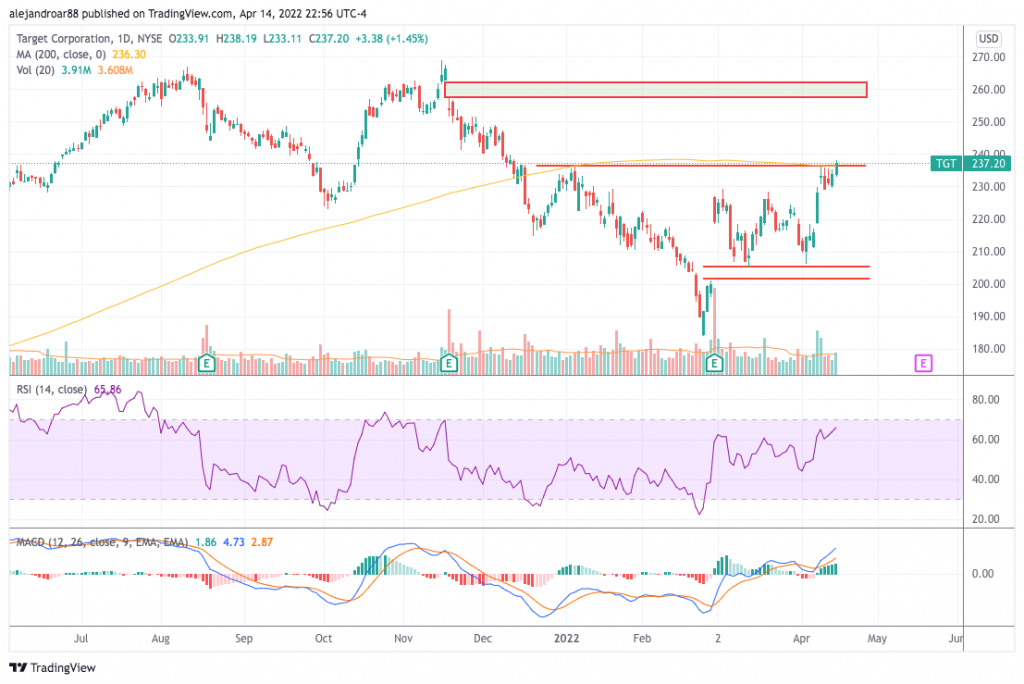Target Stock Up 12% in April – Time to Buy TGT Stock?
Please note that we are not authorised to provide any investment advice. The content on this page is for information purposes only.
The price of Target stock has surged by nearly 12% so far this month after an analyst from Gordon Haskett upgraded the stock from hold to buy while raising its price target to $300 per share.
This action appears to have set things in motion for TGT as positive momentum is picking up steam with the stock nearly breaking above some major technical thresholds.
According to analyst Chuck Grom from Gordon Haskett, Target is poised to benefit from some long-lasting pandemic-related trends including “trip consolidation”, which means that users can go to a single place to buy everything they need.
This allows consumers to save money on gasoline and it usually comes with some added bonuses such as bulk discounts. Moreover, Haskett’s analyst also stated that both online and physical store traffic has picked up recently.
In addition to this recent upgrade, the British investment bank Barclays recently named Target its top pick in the retail sector for 2022.
According to analyst Karen Short, Target is trading at attractive multiples following the broad-market decline prompted by the Russia-Ukraine conflict while she also emphasized that Target experienced a major improvement in terms of how the brand is positioned in the mind of consumers.
“45% of customers buy more than originally planned when visiting a TGT store. So footsteps matter, and TGT has clearly gained footstep/mindshare/market share during the pandemic and this will prove to be sticky in our view”, Short stated.
What could be expected from this retail stock following these two interesting pads on the back from analysts? In this article, I’ll be analyzing the price action and fundamentals of Target stock to outline plausible scenarios for the future.
67% of all retail investor accounts lose money when trading CFDs with this provider.
Target Stock – Technical Analysis

This latest uptick in TGT has pushed the performance of the stock to positive territory this year and multiple technical events could set in motion a bullish cycle if things play out in a certain way.
For example, yesterday’s price action pushed the value of TGT above the 200-day simple moving average and may have resulted in a break above a long-dated horizontal resistance at $235 per share.
It appears that this recent rally has also been supported by a double-bottom pattern that came into play once the stock tagged the $205 level for a second time on 4 April. That is another reason to believe that this could be more than just a short-lived technical rebound.
Momentum indicators are also favoring a short-term bullish outlook as the Relative Strength Index (RSI) is on an uptrend at 66 while the MACD has moved above the signal line at the same time that histogram readings have been progressively increasing.
If a decisive break above the 200-day SMA occurs in the following stock trading sessions, chances are that market participants could aim to close the open gap found at the $255 – $260. This results in a total 10% upside potential.
Target Stock – Fundamental Analysis
Last month, Target beat the market’s estimate for both revenues and earnings for the fourth quarter of the 2021 fiscal year.
Moreover, the company said that it expects to report high single-digit growth in its adjusted earnings per share both in 2022 and 2023. For this year, analysts are predicting that adjusted EPS may land at around $13.2 per share.
Based on this estimate, the stock is trading at around 17 times its forecasted adjusted EPS. If Target does achieve its goal of producing single-digit EPS growth in the next two years, that would result in a price-to-earnings-to-growth ratio of around 2.
Even though this ratio may not make Target particularly appealing from a fundamental standpoint, the company has a robust balance sheet, pays a small yet stable dividend (1.5% dividend yield), and emerged stronger from the pandemic.
Therefore, although the stock is not necessarily cheap, the business is favorably positioned to benefit in an inflationary environment as long as supply chain constraints are navigated appropriately by the management.






